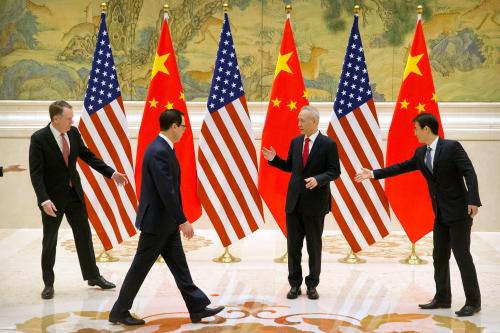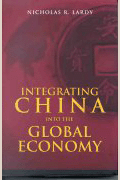This op-ed was originally published by Project Syndicate.
The biggest risks facing the world economy today stem from the escalating trade war between the United States and China. In the past few weeks, the threat has gained greater salience: As negotiations have stalled and tariffs have risen, markets around the world have registered tremors of concern. Yet most commentators fail to recognize the kind of effect an all-out clash would have on the U.S. economy, and on the world.
It is true, as U.S. President Donald Trump has repeatedly pointed out, that his country runs a large trade deficit with China. In 2018, the U.S. exported goods worth $120.3 billion to China—a substantial amount, but dwarfed by the $539.5 billion of goods that it imported from China. And while firing the latest salvo on May 10, when the U.S. hiked tariffs on $200 billion worth of Chinese goods from 10 percent to 25 percent, Trump threatened to impose the same rate on virtually all imports from China. In retaliation, China imposed reciprocal tariffs on $60 billion worth of U.S. exports, scheduled to take effect on June 1.
No one doubts that China has historically flouted many of the global norms of trade and exchange-rate management. But trying to correct this now by raising tariffs on Chinese goods is futile. Worse, it would disproportionately harm the U.S.
Trump’s tariff policy is rooted in a fundamental misunderstanding of what bilateral trade deficits mean. Consider a simple example. I am now in Nuremberg. When the bus that brought me here stopped at a service area, I went into a store and bought snacks and coffee. Because the store bought nothing from me, I ran up a trade deficit with the store, and the store had a surplus with me. By Trump’s reasoning, I would have to rush back to the store, complain about this imbalance, and insist that the store now buy an equivalent amount from me.
If every country followed that logic, we would quickly return to a world of barter, and the quality of our lives would be vastly diminished. One reason the world is prosperous today is that countries can run a deficit with one trading partner and a surplus with another.
There are many issues on which the U.S. should take a strong stand toward China, not least over the latter’s silencing of its own ethnic and religious minorities. But raising tariffs should not be America’s instrument of choice, especially now that China has moved largely to a market-based exchange-rate system.
Furthermore, China is now so globally connected that isolating it would be virtually impossible. The Chinese government’s Belt and Road Initiative of transnational infrastructure investments, for example, now involves 126 countries and 29 international organizations.
Chinese confidence is also reflected in the ironic tone of its admonitions. As Gao Feng, the spokesperson of China’s Ministry of Commerce, recently said in remarks clearly directed at Trump, “If the United States wants to continue to talk, it needs to be sincere and correct its wrong practices.”
In the meantime, the U.S. economy is likely to suffer because of the higher tariffs. Many commentators have argued that American households will bear the brunt of the costs through higher prices and reduced consumption. The price of certain clothing items will rise; and it may be time to stock up on shoes—69% of all shoes sold in the U.S. in 2018 came from China. Analysts at Oxford Economics estimate that if the Trump administration applies a 25 percent tariff on all goods imports from China, and China retaliates in kind, U.S. GDP growth in 2020 will fall by 0.5 percentage points.
As serious as the likely near-term impact is, a tariff war would have far worse long-term consequences for the U.S. economy. This is because a large share of U.S. imports from China are production inputs. Higher tariffs will make those inputs more expensive or scarcer, hurting U.S. productivity and competitiveness and taking a deep bite out of the economy’s growth potential.
In 2018, for example, the U.S. imported $29.8 billion worth of clothing from China and a further $20 billion worth of leather and related goods. Higher tariffs on these products are likely to hit American consumers. But the U.S. spent far more on production inputs, including $186.5 billion on computers and electronics, and a combined $88.6 billion on electrical equipment and machinery. If tariffs on these goods remain high, the U.S. risks being outcompeted by other countries in the same way that it outcompeted Japan after the 1980s.
U.S. policymakers should also recall the experience of India, which until 1991 imposed sky-high tariffs to protect domestic producers. India’s import barriers not only led to higher prices for Indian consumers, but also—and more important—hurt the very producers they were supposed to protect. With no access to quality inputs, Indian companies were not globally competitive. It was the government’s reforms in 1991-1993, which reduced tariffs to more reasonable levels, that finally unleashed growth.
Interestingly, China is relying only partly on tariffs to respond to Trump, and is also resorting to other measures that are likely to cost it less—such as whipping up patriotic sentiment, targeting Boeing, and protecting its tech companies. China is essentially biding its time, knowing that the U.S. is unlikely to persist with high tariffs for too long. And if it does, it will end up ceding space in the global economy to China.
The Brookings Institution is committed to quality, independence, and impact.
We are supported by a diverse array of funders. In line with our values and policies, each Brookings publication represents the sole views of its author(s).










Commentary
Op-edWhy the trade arithmetic favors China
May 31, 2019